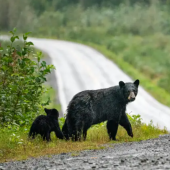With over 30 years of experience in the National Forest Service serving the South Platte Ranger District in Colorado, Scott Dollus has seen a lot of changes.
The Pike and San Isabel National Forests & Cimarron and Comanche National Grasslands (PSICC) encompass over 3 million acres of diverse forest and grasslands in the Rocky Mountains. The South Platte Ranger District serves the area along the South Platte drainage, directly west of the busy Denver urban corridor. Ranger Dollus serves as the Recreation Planner for the South Platte District.
 Pike National Forest near Kenosha Pass shows off its fall colors (Photo by TC Wait)
Pike National Forest near Kenosha Pass shows off its fall colors (Photo by TC Wait)
Our 155 National Forests were created through the Land Revision Act of 1891 in order to protect and manage natural resources for future generations. Management of these lands by the Forest Service includes everything from conservation to watershed protection to regulating logging, livestock grazing, and mining.
Forest Service Rangers roles have changed substantially over the years. With many years of contracting budgets and exponentially growing numbers of visitors, Rangers have had to take on many roles to try to best protect and preserve our National Forests.
Daily activities can vary greatly, but often include efforts to better educate the public about the forests and their uses, issuing various use permits (guides and outfitters, special events, special uses, etc), establishing and maintaining trails and motor vehicle routes, patrolling and law enforcement, and maintenance (replacing signs, cleaning up garbage, etc.).
Ranger Dollus says that one of the more recent changes that visitors may notice within the National Forests is the move to restrict dispersed camping to designated sites identified by brown signs with a tent symbol and a number.
There are several reasons behind this:
- To try to prevent “migrating” primitive campsites. You have seen them—they start near an access road, then over the years migrate further back into the trees or spread out as people look for “nicer” campsites.
- To protect water resources. Everyone likes to camp next to the water.
- To control the de-vegetation, erosion, fire potential, trash and human waste that is impacting the forests from human use. Designated camping sites allow for more efficient use of Forest Rangers to patrol and maintain areas.
When asked what are some of the biggest concerns the National Forests are dealing with currently, Ranger Dollus said again that it varies, but for the Pike forest, one of the big recent concerns are “squatters” who are essentially living in the National Forests.
Other concerns are the build-up of human waste and trash in many areas. Some dumpsters that were once available had to be removed as there was SO much trash being left piled around the bear-proof dumpsters, that it was becoming a bear attraction. Unattended fires and recreational shooting without proper safeguards are also issues that they are currently working to find a solution.
When planning a trip to visit a National Forest, Ranger Dollus offers some tips to make your stay more enjoyable.
- Busy weekends fill up fast! As of now, dispersed camping sites are on a first-come, first-served basis. Plan ahead for holidays and come with lots of back-up plans.
- Check with the local Ranger District before your visit. You can learn about camping areas, any burn restrictions, or other attractions that may be interesting for your trip. There is a lot of information available online, but Ranger Dollus suggests giving a call to the local district as well.
- Know what is allowed and follow the rules. Recreational shooting, for example, may not be allowed in some places. If it is allowed, there are rules to follow (safe backstop, at least 150 yards from a trail, road, campsite, or occupied area, not over water, manufactured targets only, etc.)
- Pack out what you bring in. This includes trash, dog waste, human waste, and food. Leave the area where you have been in better condition than when you arrived.
- Report problems to the Forest Supervisor’s Office or the local sheriff first. They will know how to get in touch with the local rangers.
Get out this summer and enjoy one of America’s greatest treasures, our National Forests. The great outdoors is the reason that we have RVs, and keeping our natural resources protected with responsible use helps ensure that the forests remain wild and available to future generations.
See also: Campground Littered With Garbage, Causes Facilities To CloseThe post Useful Tips From National Forest Ranger Scott Dollus appeared first on RV Life.





